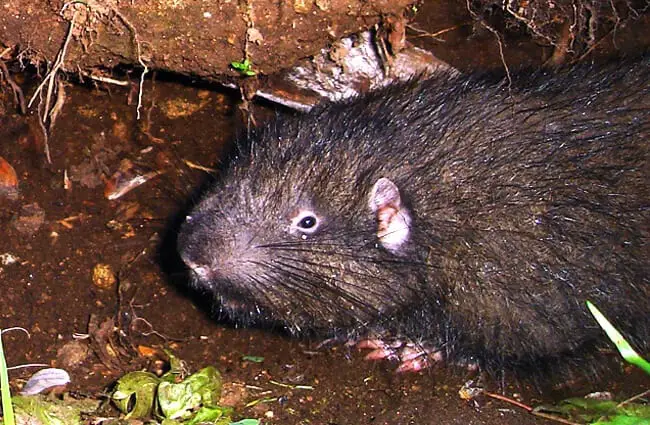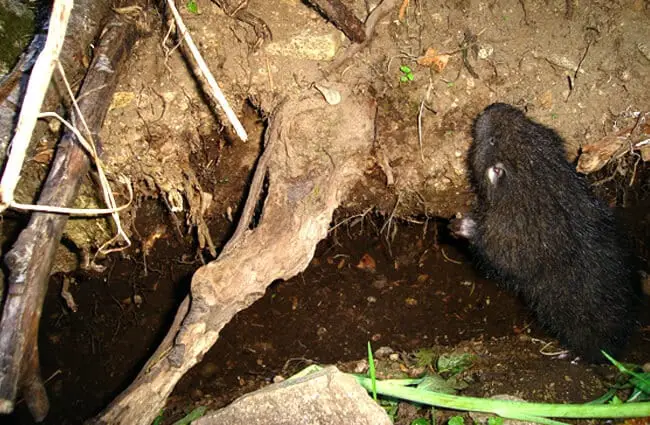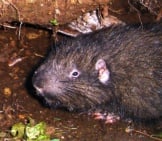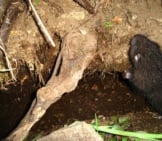The Mountain Beaver is a large rodent that lives in the northwest United States. Contrary to what their name might suggest, this species is actually not closely related to the North American or Eurasian beaver. In fact, its closest relatives are the squirrels, dormice, chipmunks, flying squirrels, and marmots. Read on to learn about the Mountain Beaver.
Description of the Mountain Beaver
From a distance, this species might look a little like a “true” beaver. However, the resemblance is short-live. This rodent is quite large, but not quite as large as the North American beaver, and that’s about all they have in common.
These mammals have grayish-brown fur with a small white patch behind each ear. They also have extremely short tails. Most adults measure about 15 in. long, but they may reach lengths up to 18 in. or so. The average weight of an adult is about 2 or 3 lbs.
Interesting Facts About the Mountain Beaver
Learn more interesting facts and fun tidbits about this unique species, below.
- Misnomer – Whoever named this species needs to admit that it was a bit of a stretch. These rodents do not reach quite the size of their “true” beaver cousins, they don’t have the characteristic flattened tail, they don’t chew down trees, nor do they build dams.
- Similarities – Though the name is admittedly a stretch, these rodents are quite large compared to the other North American members of the rodent family. They also prefer riparian habitats, or regions in close proximity to water.
- Mountain Beaver Flea – This species of rodent harbors the largest species of flea in the world. Some individual fleas reach 0.3 in. long! That’s 30 times the size of a typical dog or cat flea.
- Subspecies – Researchers recognize seven different subspecies of this rodent. The various subspecies live in different regions of the Northwest.
Habitat of the Mountain Beaver
Though they bear the term “mountain” in their name, these rodents also live at sea level. They live in various forests, including mountainous regions, deciduous, shrub, and more.
For the most part, these beavers prefer riparian areas, or regions closely associated with water. Most live in close proximity to streams or creeks for this reason.
Distribution of the Mountain Beaver
You can find this species from California to southern British Columbia. Their range extends from San Francisco up the coast, but they also have a population that runs along the Sierra Nevada Mountains. From northern California, their range extends through western Oregon and Washington, into southern Canada.
Diet of the Mountain Beaver
This rodent is an herbivore, which means that they eat only plants. Researchers are unsure of the exact composition of the diet of this species. We do know that they feed on young trees and eat the bark of older trees. They also eat ferns and other small shrubs.
Mountain Beaver and Human Interaction
Humans in some regions view this species as a pest because they feed on tree saplings, or young trees. However, for the most part these rodents do not interact with humans frequently. Human activity does not severely impact their populations in any way and the IUCN lists this species as Least Concern.
Domestication
Humans have not domesticated this species in any way.
Does the Mountain Beaver Make a Good Pet
No, this large rodent does not make a good pet. It is a wild animal, is not friendly towards humans, and it bears an unpleasant and musky odor.
Mountain Beaver Care
This species is uncommon in zoos and aquariums, though on one occasion this rodent actually broke into the Oregon zoo! Because zoos do not commonly keep these creatures, little is known about their housing or care.
Behavior of the Mountain Beaver
These large rodents hold territories around a home burrow. They do not share this burrow with any other members of the same species, and will attack intruders. Outside of the breeding season, the only interaction these creatures have with one another is through scent marking and booming calls.
Reproduction of the Mountain Beaver
Breeding typically occurs in February and March. After mating, females have a gestation period lasting about seven weeks. Litters usually contain two or three young. It takes between six and eight weeks for the young to reach independence, and most do not reproduce until they are at least two years old.





![Red Angus Closeup of a beautiful Red Angus cowPhoto by: U.S. Department of Agriculture [pubic domain]https://creativecommons.org/licenses/by/2.0/](https://animals.net/wp-content/uploads/2020/03/Red-Angus-4-238x178.jpg)












![Red Angus Closeup of a beautiful Red Angus cowPhoto by: U.S. Department of Agriculture [pubic domain]https://creativecommons.org/licenses/by/2.0/](https://animals.net/wp-content/uploads/2020/03/Red-Angus-4-100x75.jpg)

